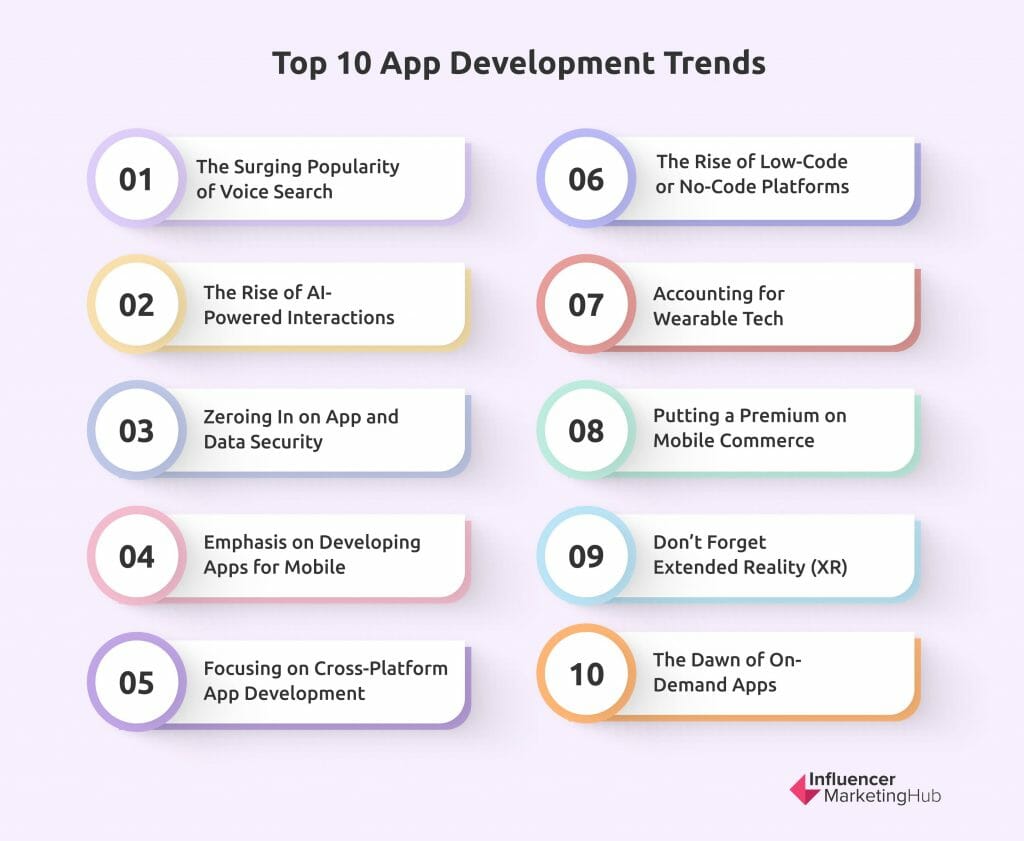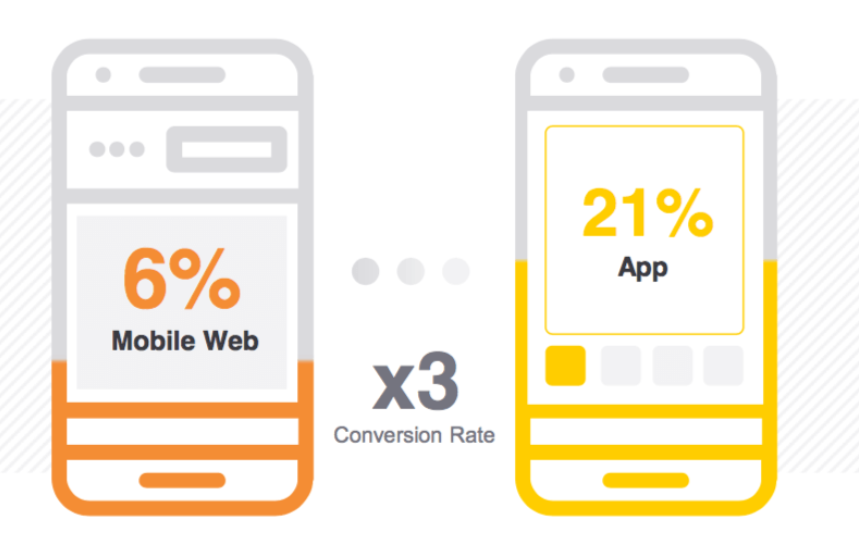Applications, whether they’re for the web, mobile, or desktop, have become an integral part of our daily lives. From mobile games to lifestyle, apps come in all shapes and sizes and cater to different users’ unique needs. And thanks to the internet, it has become easier for people to search for an app that fits their requirements and download it.
Let’s take a closer look at apps and 10 app development trends, so you can stay ahead of the curve.
Top App Development Trends to Look Out for in 2023:
- 1. The Surging Popularity of Voice Search
- 2. The Rise of AI-Powered Interactions
- 3. Zeroing In on App and Data Security
- 4. Emphasis on Developing Apps for Mobile
- 5. Focusing on Cross-Platform App Development
- 6. The Rise of Low-Code or No-Code Platforms
- 7. Accounting for Wearable Tech
- 8. Putting a Premium on Mobile Commerce
- 9. Don’t Forget Extended Reality (XR)
- 10. The Dawn of On-Demand Apps
- Frequently Asked Questions
The Popularity of Apps
In the US alone, Pew Research reported that 85% of Americans owned a smartphone in 2021, a significant increase from 2011’s 35%.

Source: pewresearch.org
The same study also indicates that a majority of the US population (three-quarters of adults) own a laptop or a computer, while almost half own a tablet.

Source: pewresearch.org
Compared to 2016, which raked in almost 141 billion mobile app downloads, 2021 saw a sharp 63% increase, with 230 billion downloads and with mobile gaming apps taking the lion’s share of the downloads.
It’s projected that from 2020 to 2025, the mobile app market share will grow to more than $650 billion, with a market growth momentum indicating an almost 21% compound annual growth rate. A majority of this market growth (46%) will come from the APAC region, which includes China and India.

Source: mma.prnewswire.com
One of the main drivers of the mobile app market’s growth is the continued rise of eCommerce, which generated a total of $870 billion in sales in the US alone (2021), making up 13.2% of all retail sales in the country that same year.
Despite the steadily rising popularity of apps and app development, the industry is constantly evolving due in part to the rapidly changing market demands and consumer behavior. With these shifts come a range of business opportunities for individuals and businesses looking to tap into the market’s seemingly endless potential. But how do you know which direction to take or what decisions can have an impact on your business? Learning about the latest and emerging trends can help you stay ahead of the curve and get some insight into the possible direction that the app development industry is heading toward.
Top 10 App Development Trends to Watch Out For

1. The Surging Popularity of Voice Search
Voice search has been gaining traction these past few years, thanks to the development of digital assistants like Siri, Alexa, and Google Assistant. It’s estimated that by 2023 the number of digital assistants in use will go up to 8 billion and along with this, the substantial growth of voice commerce, particularly for digital purchases.
As more people start to have access to such technologies, developers and businesses must rethink the way they approach search engines. Because voice search wasn’t designed solely for eCommerce, you need to make sure that both your app and website are discoverable via voice search queries. This means optimizing your app for voice search by looking into methods like using schema markup or structured data.
2. The Rise of AI-Powered Interactions
AI will take center stage in web app development owing to the popularity of personalization and automation. Because consumers want products, services, or search results that are relevant and of value to them, you can leverage AI to improve interaction, drive engagement, and deliver a better customer experience to your visitors. For example, chatbots can assist visitors with FAQs or other inquiries and concerns. So instead of calling your business for questions about your store hours, visitors can use your AI chatbots instead.
3. Zeroing In on App and Data Security
A data breach can have serious consequences for both you and your users. Aside from both parties’ data being compromised, your reputation and credibility will be adversely affected, and you may end up suffering losses. If you’re thinking of entering the app development market this year, make sure that you have app and data security measures in place.
You’ll have to test your app’s security during the development stage and when you make any changes to the app to make sure that it has no vulnerabilities. You may also want to consider limiting access to certain areas of your app or website, which can help improve security. For example, you can assign roles or implement multi-factor authentication to strengthen security.
4. Emphasis on Developing Apps for Mobile
Mobile devices are one of the major sources of internet traffic. Additionally, given the fact that more and more people are having access to mobile devices, app developers should think about developing web apps for mobile users. Now, this doesn’t mean taking your web app and converting the whole thing for mobile. When designing a mobile version of your app, you need to consider your existing web experience. What elements work for it and what doesn’t? When transitioning from a website or a web app to a mobile one, you need to ensure that there’s continuity. Include elements that your users are already familiar with, and, if possible, avoid adding tons of extra features that might affect user experience.
5. Focusing on Cross-Platform App Development
Cross-platform development is expected to become more popular in the coming years, given that platform development often comes with steep price tags and legacy apps usually only serve a limited purpose. Also, cross-platform app development gives you an app that can work on different operating systems, whether it’s iOS, Android, Windows, or any other OS. With this approach, you can save on app development costs, as you’re essentially working on developing an app using a single programming language and thus have a single code base. Aside from being cost-effective, cross-platform app development offers a quick turnaround because you won’t have to start building an app from scratch for each operating system. You’ll also be able to offer more consistent UI/UX to users regardless of the platform they’re using.
6. The Rise of Low-Code or No-Code Platforms
Low-code and no-code (LCNC) platforms make it easier for everyday people like you and me to become citizen developers and create our own custom apps that are built to meet our specific needs. Such platforms effectively lower the barrier to entry for app development because users can still build apps even if they have little to no programming background. No-code platforms, for example, often have a user-friendly, drag-and-drop interface that greatly speeds up the development of enterprise-grade apps.
Overall, the market for such platforms is expected to grow in the future, and more executives are seeing LCNC platforms as crucial investments. In the case of low-code platforms alone, it’s projected that its market will generate $187 billion in revenue by 2030, indicating a 31.1% CAGR from 2020 to 2030.
7. Accounting for Wearable Tech
Aside from LCNC platforms, wearable devices such as smartwatches and fitness trackers are also generating a lot of buzz. Thus, it’s expected that this year, mobile apps will be developed with such technologies in mind. This means designing mobile apps that can easily integrate with wearable tech or building apps for wearables themselves to make them independent of mobile devices.
8. Putting a Premium on Mobile Commerce
Mobile apps are increasingly being used to generate revenue. They’re great sources for conversions, delivering higher conversion rates compared to their mobile web counterparts. They’re also driving more eCommerce transactions compared to transactions done on desktop computers.

Source: martech.org
Furthermore, it’s estimated that by 2024, there will be close to 190 million mobile shoppers in the US alone. These indicate that mobile apps are playing a significant role in influencing the potential growth of mobile commerce in the future. Don’t have a mobile app yet? No problem. What you can do right now is to make sure that your website is optimized for mobile to minimize the risk of visitors leaving your site only to go to another website.
9. Don’t Forget Extended Reality (XR)
Extended reality (XR) technologies like augmented reality and virtual reality will continue to become more mainstream in the coming years. Today, we’re already seeing how existing technologies incorporate XR into our daily lives, from social media AR filters and AR mobile gaming apps like Pokémon GO to virtual tours and product experiences. This increasingly widespread use of XR technologies is increasingly influencing the direction of app development trends. To get in on this trend, you can, for example, create an app that has AR or VR-based programs or features that players can use in games or organizations can use for training programs.
10. The Dawn of On-Demand Apps
The on-demand services market is a lucrative market that attracts more than 22 million users and rakes in close to $60 billion in spending, according to the Harvard Business Review. The same report highlights the fact that the on-demand economy, which includes industries like freelancing services, deliveries, health and beauty services, and transportation, continues to grow.
What does this mean for app developers? Working on on-demand apps can help you offer more features or functionalities that can meet your audience’s changing needs. One trend to look out for when it comes to on-demand apps is that they’re expected to become more personalized. It’s also highly likely that this app development model will become more popular given the advent of platforms that simplify the app development process.
Be Ahead of the App Development Curve
The right app can help make your brand or business more visible and accessible to your target audience. Aside from more obvious benefits like helping generate sales and fostering greater brand awareness, it can also become a valuable marketing tool that can be used to build brand loyalty and bring your business in front of new potential customers.
By staying on top of trends, you can incorporate novel ideas into your business, make research-based predictions, and have the opportunity to establish yourself as an authority in your niche. Furthermore, you’ll be in the loop when it comes to conversations about the latest industry developments. You can take part in important conversations about apps and app development and share your experiences with some of these emerging trends and technologies.
Frequently Asked Questions
What are apps?
An application or app is a type of software that you can download and install on your PC or laptop, smartphone, or tablet. When we say “apps”, we’re referring to both mobile apps and desktop apps. Apps are usually characterized as having a limited or specific function. For example, gaming apps are designed solely for gaming, while food delivery apps are intended solely for food delivery and often can’t be used for other purposes like making a reservation.
The rise of apps played a key role in the diversification of its uses. Aside from being utilized for gaming, for example, apps nowadays can be used to generate business by becoming advertising channels. There are several mobile app verticals available, but here are some of the most common ones:
- Gaming – Pokémon GO, Roblox, Genshin Impact, and Candy Crush Saga
- Social – Instagram, Facebook, Twitter, and TikTok
- Entertainment – YouTube, Netflix
- eCommerce (retailers and platforms)– eBay, Amazon, Amazon Seller Central, Etsy, and Shopify
When it comes to desktop apps, some of the most popular ones include Microsoft Word, Adobe Photoshop, Dropbox, and Skype for Windows.
What are some of the most popular apps being used today?
In a report by RiskIQ, it was estimated that there were 8.9 million apps in 2020 alone. Out of these millions of apps, only a handful enjoy a significant number of downloads, often falling into the hundred-million mark. Some of 2021’s most downloaded apps include:
- TikTok
- Roblox
- Zoom
- Spotify
- Among Us
- Subway Surfers
- Messenger
What are the tools used to develop apps?
It used to be that building apps required knowledge of programming and various programming languages, such as Python and C++. While this still holds true to this day, there are now platforms that let you develop apps with little to no coding knowledge. These are known as low-code or no-code platforms.
How do you develop an app?
Every great app starts with an equally great idea. Prior to dipping your toes in the app development landscape entirely, here are the basic steps to follow when planning to build an app. First, you need to ask yourself some very important questions, such as:
- Is the app you’re planning to create new, or does it offer users a new experience?
- Is it capable of solving your audience’s pain points?
- Can it help improve your business?
You also need to have a good understanding of the market you’re going to be in, including your competitors and target market. Once you’ve laid the groundwork for your app, you need to create mockups of what your app is going to look like, which should then be followed by a prototype.
After prototyping, you need to test your app and get feedback from actual users, who can help you identify any issues with your app, like bugs or problems with UI. Once you’re happy with the outcome, you can work on a marketing plan before launching your app. Having a marketing plan in place can help you launch your app successfully.
What are the commonly used programs for app development?
The app development software you’re going to use will depend on the kind of app you’re building and the features, such as mobile payment and AR, you want to have. Some of the commonly used app development software include:
- Quixy
- Zoho Creator
- Jira
- Appy Pie
- Xamarin


